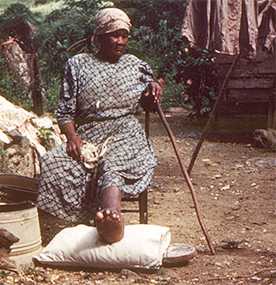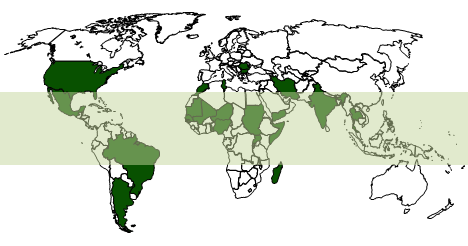Mycetoma
Mycetoma is a disease caused by certain types of bacteria and fungi found in soil and water. These bacteria and fungi may enter the body through a break in the skin, often on the person’s foot. The resulting infection causes firm, usually painless but debilitating masses under the skin that can eventually affect the underlying bone. Mycetoma can be caused by bacteria (actinomycetoma) or fungi (eumycetoma). The number of people with mycetoma worldwide is not known, but there were 8,763 cases reported in a 2013 review of scientific articles between 1950 and 2013. The actual number of cases is likely substantially higher.
Mycetoma affects people of all ages and is more common in men. This disease primarily affects poorer people in rural regions of Africa, Latin America, and Asia that are located near Earth’s equator and have dry climates. Mycetoma has rarely been reported in the United States in recent decades. A review of the literature from 1890 to 2014 showed fewer than 80 cases occurring in the US. Travelers from the United States to areas where mycetoma has been reported are at low risk of getting mycetoma. This is because developing mycetoma requires repeatedly exposing broken skin to soil and water that contain the microbes that cause mycetoma, over long periods of time, and travelers are unlikely to have enough exposure to be at risk.

Woman with a swollen leg caused by mycetoma.
Diagnosis requires laboratory evaluation of a biopsy, or small tissue sample, of the infected area. The treatment for mycetoma includes antibiotics or antifungal medication, depending on which type of microbe is causing it, and surgery is sometimes needed to cut away the infected tissue. Wearing shoes might help prevent mycetoma.
Symptoms
Symptoms are similar for bacterial and fungal mycetoma. Both appear as firm, painless masses under the skin. These masses usually appear on a person’s foot but can form anywhere on the body. The mycetoma masses start small, but over time they can grow larger, develop oozing sores, and cause the affected limb to become deformed or unusable. If mycetoma is not treated or if treatment fails, it can spread to other areas of the body. Long-term mycetoma can eventually destroy the underlying muscle and bone.
Risk & Prevention
Mycetoma is a health problem in equatorial regions of Africa, Latin America, and Asia known as the “mycetoma belt.” Fungal mycetoma (eumycetoma) is the most common type in Africa, while bacterial mycetoma (actinomycetoma) causes most cases in South and Central America and some Asian countries.

Countries shown in dark green indicate those in which cases of mycetoma have been reported in the medical literature. The mycetoma belt region is shaded in light green.
Mycetoma affects people of all ages and is more common in men. Many people with mycetoma work in agricultural jobs, such as farmers and livestock herders. Mycetoma has rarely been reported in the United States in recent decades. A review of the literature (1890–2014) showed fewer than 80 cases occurring in the US.
Health care providers and researchers believe that wearing shoes might prevent injuries that cause mycetoma because they protect the feet while walking or working outside in areas where the germs that cause mycetoma are common in water and soil. Early detection and treatment, before symptoms cause serious effects, can reduce disabilities from mycetoma and may cure the condition.
Transmission
The bacteria and fungi that cause mycetoma live in soil and water. These germs can enter the body through wounds or other small skin injuries, like a thorn prick. It is not known why some people develop mycetoma and others do not, but aspects of the environment and living conditions are likely involved. Mycetoma does not spread between people.
Diagnosis
A doctor can diagnose mycetoma by taking a small sample (biopsy) of the infected area of the body and sending it to a laboratory. The laboratory may examine the sample under a microscope, but this test may not always determine if the infection is caused by bacteria or fungi and cannot determine what type of bacteria or fungus is the cause of the mycetoma. A culture (growing the bacteria or fungi in the laboratory) can determine the specific type of bacteria or fungus causing the infection. A doctor may also do an imaging test such as an X-ray or ultrasound to diagnose mycetoma and see how much damage has taken place to muscle and bone. Patients can avoid long-term infection and amputation by seeking care and detecting and treating mycetoma early.
Treatment
The treatment for mycetoma depends on whether it is caused by bacteria (actinomycetoma) or fungi (eumycetoma).
- Actinomycetoma is usually treatable with antibiotics, and surgery is usually not needed.
- Eumycetoma is usually treated with long-term antifungal medication, but treatment may not be completely effective. In this case, surgery or amputation are sometimes needed to cut away the infection tissue.
Resources
- World Health Organization: Mycetoma
- Mycetoma: The Faces of Neglect – Professor Fahal
- Mycetoma: Hope for a Devastating Neglected Disease
- van de Sande WW. Global burden of human mycetoma: a systematic review and meta-analysis. PLoS neglected tropical diseases. 2013 Nov;7(11):e2550.
- van de Sande WW, Maghoub el S, Fahal AH, Goodfellow M, Welsh O, Zijlstra E. The mycetoma knowledge gap: identification of research priorities. PLoS neglected tropical diseases. 2014 Mar;8(3):e2667.
- Zijlstra EE, van de Sande WW, Welsh O, Mahgoub el S, Goodfellow M, Fahal AH. Mycetoma: a unique neglected tropical disease. Lancet Infect Dis. 2016 Jan;16(1):100-12.
- Page last reviewed: May 31, 2017
- Page last updated: May 31, 2017
- Content source:


 ShareCompartir
ShareCompartir